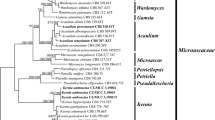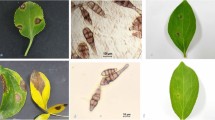Abstract
The internal transcribed spacer regions (ITS1 and ITS2) of ribosomal DNA from Alternaria species, including seven fungi known to produce host-specific toxins, were analyzed by polymerase chain reaction-amplification and direct sequencing. Phylogenetic analysis of the sequence data by the Neighbor-joining method showed that the seven toxin-producing fungi belong to a monophyletic group together with A. alternata. In contract, A. dianthi, A. panax, A. dauci, A. bataticola, A. porri, A. sesami and A. solani, species that can be morphologically distinguished from A. alternata, could be clearly separated from A. alternata by phylogenetic analysis of the ITS variation. These results suggest that Alternaria pathogens which produce host-specific toxins are pathogenic variants within a single variable species, A. alternata.
Similar content being viewed by others
References
Adachi Y, Watanabe H, Tanabe K, Doke N, Nishimura S, Tsuge T (1993) Nuclear ribosomal DNA as a probe for genetic variability in the Japanese pear pathotype of Alternaria alternata. Appl Environ Microbiol 59:3197–3205
Anderson JB, Stasovski E (1992) Molecular phylogeny of northern hemisphere species of Armillaria. Mycologia 84:505–516
Baura G, Szaro TM, Bruns TD (1992) Gastrosuillus laricinus is a recent derivative of Suillus grevillei: molecular evidence. Mycologia 84:592–597
Bottini AT, Gilchrist DG (1981) Phytotoxins. I. Al-aminodimethyl-heptadecapentol from Alternaria alternata f. sp. lycopersici. Tetrahedron Lett 22:2719–2722
Bruns TD, White TJ, Taylor JW (1991) Fungal molecular systematics. Ann Rev Ecol Syst 22:525–564
Carbone I, Kohn LM (1993) Ribosomal DNA sequence divergence within internal transcribed spacer 1 of the Sclerotiniaceae. Mycologia 85:415–427
Ellis MB (1971) Dermatiaceous Hyphomycetes. Commonwealth Mycological Institute. Kew, England
Felsenstein J (1985) Confidence limits on phylogenies: an approach using the bootstrap. Evolution 39:783–791
Felsenstein J (1991) PHYLIP-phylogenetic inference package. Computer programs distributed by Department of Genetics, University of Washington, Seattle, Washington
Furlong JC, Forbes J, Robertson M, Maden BEH (1983) The external transcribed spacer and preceding region of Xenopus borealis rDNA: comparison with the corresponding region of Xenopus laevis rDNA. Nucleic Acids Res 11:8183–8196
Gardes M, White TJ, Fortin JA, Bruns TD, Taylor JW (1991) Identification of indigenous and introduced symbiotic fungi in ectomycorrhizae by amplification of nuclear and mitochondrial ribosomal DNA. Can J Bot 69:180–190
Gardner JM, Koto Y, Tatum JH, Suzuki Y, Takeuchi S (1985) Structure of the major component of ACRL-toxins, host-specific pathotoxic compounds produced by Alternaria citri. Agric Biol Chem 49:1235–1238
Grogan RG, Kimble KA, Misaghi I (1975) A stem canker disease of tomato caused by Alternaria alternata f. sp. lycopersici. Phytopathology 65:880–886
Guadet J, Julien J, Lafay JF, Brygoo Y (1989) Phylogeny of some Fusarium species, as determined by large-subunit rRNA sequence comparison. Mol Biol Evol 6:227–242
Henrion B, Chevalier G, Martin F (1994) Typing truffle species by PCR amplification of the ribosomal DNA spacers. Mycol Res 98:37–43
Jukes TH, Cantor CR (1969) Evolution of protein molecules. In: Munro HN (ed) Mammalian protein metabolism. Academic Press, New York, pp 21–132
Kasuga T, Woods C, Woodward S, Mitchelson K (1993) Heterobasidion annosum 5.8 s ribosomal DNA and internal transcribed spacer sequence: rapid identification of European intersterility groups by ribosomal DNA restriction polymorphism. Curr Genet 24:433–436
Kimura N, Tsuge T (1993) Gene cluster involved in melanin biosynthesis of the filamentous fungus Alternaria alternata. J Bacteriol 175:4427–4435
Kodama M, Suzuki T, Otani H, Kohmoto K, Nishimura S (1990) Purification and bioassay of host-selective AT-toxin from Alternaria alternata causing brown spot of tobacco. Ann Phytopathol Soc Jpn 56:628–636
Kohmoto K, Itoh Y, Shimomura N, Kondoh Y, Otani H, Kodama M, Nishimura S, Nakatsuka S (1993) Isolation and biological activities of two host-specific toxins from the tangerine pathotype of Alternaria alternata. Phytopathology 83:495–502
Kono Y, Gardner JM, Suzuki Y, Takeuchi S (1986) Studies on hostselective toxins produced by a pathotype of Alternaria citri causing brown spot disease of mandarins. Agric Biol Chem 50: 1597–1606
Kuninaga S, Yokosawa R (1987) Studies on the taxonomy of plant pathogenic fungi by a comparison of DNA homology. I. Genetic relatedness among species in the genus Alternaria (in Japanese). Ann Phytopathol Soc Jpn 53:368–369
Kuninaga S, Yokosawa R (1989) Genetic relatedness within and between formae speciales of Fusarium oxysporum as measured by DNA-DNA reassociation kinetics. Ann Phytopathol Soc Jpn 55:216–223
Kurtzman CP (1987) Impact of nucleic-acid comparisons on the classification of fungi. Proc Indian Acad Sci (Plant Sci) 97:185–201
Kusaba M, Tsuge T (1984) Nuclear ribosomal DNA variation and pathogenic specialization in Alternaria fungi known to produce host-specific toxins. Appl Environ Microbiol 60:3055–3062
Lucas GB (1975) Diseases of tobacco. Biological Consulting Associates, Raleigh, North Carolina
Maekawa N, Yamamoto M, Nishimura S, Kohmoto K, Kuwata M, Watanabe Y (1984) Studies on host-specific AF-toxins produced by Alternaria alternata strawberry pathotype causing Alternaria black spot of strawberry. I. production of host-specific toxins and their biological activity. Ann Phytopathol Soc Jpn 50:600–609
Morales VM, Pelcher LE, Taylor JL (1993) Comparison of the 5.8 s rDNA and internal transcribed spacer sequences of isolates of Leptosphaeria maculans from different pathogenicity groups. Curr Genet 23:490–495
Nakashima T, Ueno T, Fukami H, Taga T, Masuda H, Osaki K, Otani H Kohmoto K, Nishimura S (1985) Isolation and structures of AK-toxin I and II, host-specific phytotoxic metabolites produced by Alternaria alternata Japanese pear pathotype. Agric Biol Chem 49:807–815
Nakatsuka S, Ueda K, Goto T, Yamamoto M, Nishimura S, Kohmoto K (1986) Structure of AF-toxin II, one of the host-specific toxins produced by Alternaria alternata strawberry pathotype. Tetrahedron Lett 27:2753–2756
Nazar RN, Hu X, Schmidt J, Culham D, Robb J (1991) Potential use of PCR-amplified ribosomal intergenic sequences in the detection and differentiation of verticillium with pathogens. Physiol Mol Plant Pathol 39:1–11
Neergaard P (1945) Danish species of Alternaria and Stemphylium. Einar Munksgaard, Copenhagen
Nishimura S (1980) Host-specific toxins from Alternaria alternata: problem and prospects. Proc Jpn Acad Ser B 56:362–366
Nishimura S, Kohmoto K (1983) Host-specific toxins and chemical structures from Alternaria species. Annu Rev Phytopathol 21:87–116
Nishimura S, Sugihara M, Kohmoto K, Otani H (1978) Two different phases in pathogenicity of the Alternaria pathogen causing black spot disease of Japanese pear. J Fac Agric Tottori Univ 13:1–10
Nishimura S, Kohmoto K, Otani H, Ramachandran P, Tamura F (1982) Pathological and epidemiological aspects of Alternaria alternata infection depending on a host-specific toxin. In: Asada Y, Bushnell WR, Ouchi S, Vance CP (eds) Plant infection: the physiological and biochemical basis. Japan Scientific Societies Press, Tokyo Springer-Verlag, Berlin Heidelberg New York, pp 199–214
Okuno T, Ishata Y, Sawai K, Matsumoto T (1974) Characterization of alternariolide, a host-specific toxin produced by Alternaria mali Roberts. Chem Lett 1974:635–638
Otani H, Kohmoto K (1992) Host-specific toxins of Alternaria species. In: Chelkowski J, Visconti A (eds) Alternaria: biology, plant diseases and metabolites. Elsevier, Amsterdam, pp 123–156
Pegg KG (1966) Studies of a strain of Alternaria citri Pierce, the causal organism of brown spot of Emperor mandarin (Citrus reticulata). Queensland J Agric Anim Sci 23:15–28
Rotem J (1994) The genus Alternaria: biology, epidemiology and pathogenicity. The American Phytopathological Society. St. Paul, Minnesota
Ruehle GD (1937) A strain of Alternaria citri Ellis & Pierce causing a leaf spot of rough lemon in Florida. Phytopathology 27:863–865
Saitou N, Nei M (1987) The neighbor-joining method: a new method for reconstructing phylogenetic trees. Mol Biol Evol 4:406–425
Sawamura K (1962) Studies on spotted diseases of apples. I. The causal agent of Alternaria blotch. Bull Tohoku Natl Agric Exp Stn 23:163–175
Scheffer RP, Livingston RS (1984) Host-selective toxins and their role in plant diseases. Science 223:417–421
Simmons EG (1967) Typification of Alternaria, Stemphylium, and Ulocladium, Mycologia 59:67–92
Simmons EG (1992) Alternaria taxonomy: current status, viewpoint, challenge. In: Chelkowski J, Visconti A (eds) Alternaria: biology, plant diseases and metabolites. Elsevier, Amsterdam, pp 1–35
Simmons EG (1993) Alternaria themes and variations (63–72). Mycotaxon 48:91–107
Simmons EG, Roberts RG (1993) alternaria themes and variations (73). Mycotaxon 48:109–140
Sreenivasaprasad S, Mills PR, Brown AE (1994) Nucleotide sequence of the rDNA spacer 1 enables identification of isolates of Colletotrichum as C. acutatum. Mycol Res 98:186–188
Swofford DL (1993) PAUP phylogenetic analysis using parsimony. Computer program distributed by the Illinois Natural History Survey, Champaign, Illinois
Takeuchi T, Kuninaga S (1994) Genetic relationships in Pseudocercosporella herpotrichoides determined from DNA relatedness. Mycol Res 98:1059–1064
Tanaka S (1933) Studies on black spot disease of the Japanese pear (Pyrus serotina Rehd.). Mem Coll Agric Kyoto Imp Univ 28:1–31
Tsuge T, Kusaba M, Katsuya S, Shiotani H, Kimura N, Adachi Y (1993) Molecular biology of AK-toxin production by the Japanese pear pathotype of Alternaria alternata. In: Kohmoto K, Yoder OC (eds) Host-specific toxin: biosynthesis, receptor and molecular biology. Tottori University Press, Tottori, pp 239–250
Tsuge T, Kobayashi H, Nishimura S (1989) Organization of ribosomal RNA genes in Alternaria alternata Japanese pear pathotype, a host-selective AK-toxin-producing fungus. Curr Genet 16:267–272
Veldman GM, Klootwijk J, van Heerikhuizen H, Planta RJ (1981) The nucleotide sequence of the intergenic region between the 5.8 s and 26 s rRNA genes of the yeast ribosomal RNA operon. Possible implications for the interaction between 5.8 and 26 s rRNA and the processing of the primary transcript. Nucleic Acids Res 9:4847–4862
Waterman MS (1986) Multiple sequence alignment by consensus. Nucleic Acids Res 14:9095–9102
Wayne LG, Brenner DJ, Colwell RR, Grimont PAD, Kandler O, Krichevsky MI, Moore LH, Moore WEC, Murray RGE, Stackebrandt E, Starr MP, Trüper HG (1987) Report of the ad hoc committee on the reconciliation of approaches to bacterial systematics. Int J Syst Bacteriol 37:463–464
White TJ, Bruns T, Lee S, Taylor J (1990) Amplification and direct sequencing of fungal ribosomal RNA genes for phylogenetics. In: Innis MA, Gelfand DH, Sninsky JJ, White TJ (eds) PCR protocols. A guide to methods and applications. Academic Press, San Diego, California, pp 315–322
Yoder OC (1980) Toxins in pathogenesis. Annu Rev Phytopathol 18:103–129
Yu SH (1992) Occurrence of Alternaria species in countries of the Far East and their taxonomy. In: Chelkowski J, Visconti A (eds) Alternaria: biology, plant diseases and metabolites. Elsevier, Amsterdam, pp 37–62
Zambino PJ, Szabo LJ (1993) Phylogenetic relationships of selected cereal and grass rusts based on rDNA sequence analysis. Mycologia 85:401–414
Author information
Authors and Affiliations
Additional information
Communicated by B. G. Turgeon
This paper is dedicated to the late Syoyo Nishimura
Rights and permissions
About this article
Cite this article
Kusaba, M., Tsuge, T. Phologeny of Alternaria fungi known to produce host-specific toxins on the basis of variation in internal transcribed spacers of ribosomal DNA. Curr Genet 28, 491–498 (1995). https://doi.org/10.1007/BF00310821
Received:
Issue Date:
DOI: https://doi.org/10.1007/BF00310821




